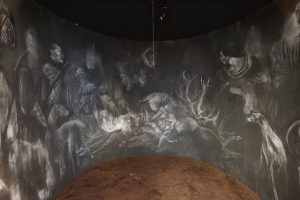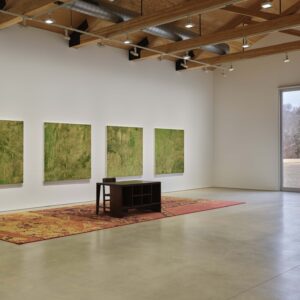Outrageous Algorithms, a mobile artwork by Rachel Ara that challenges the mythology of algorithms. Conceptual artist Rachel Ara uses her ex-AA van as a mobile gallery (MoVA), to take her work out whilst access to galleries and museums remains limited. Borrowing the branding style from a well known breakdown company Ara creates Outrageous Algorithms, a new and specialist service for today’s emergencies – a 24hr Mental Breakdown Service.
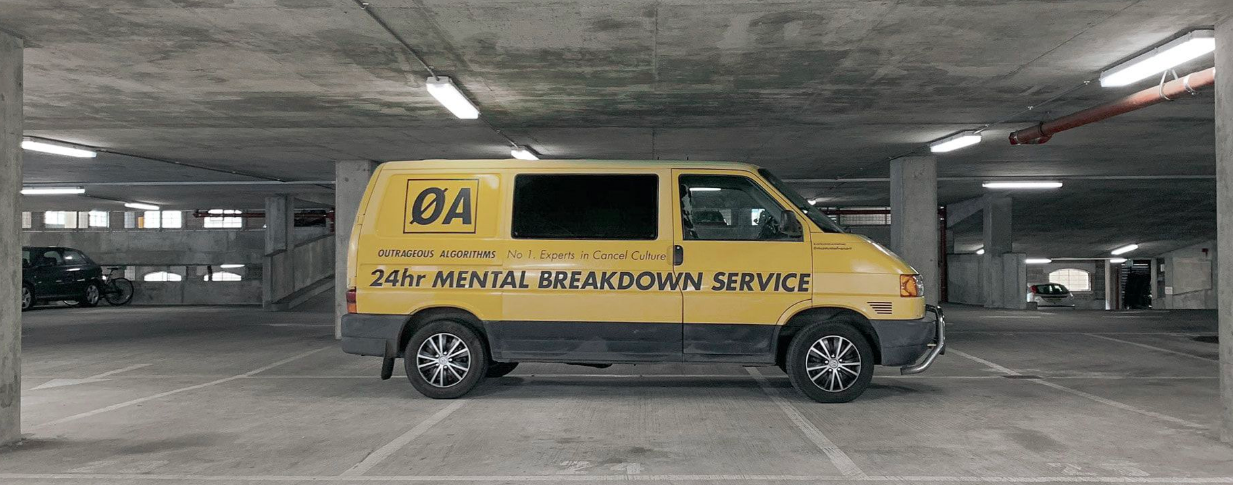
In reference to advertising straplines on tradesman’s vans, ØA provides ‘all aspects of the trade’ in data manipulation. The van boasts that ØA are No.1 experts in Manipulating Outcomes and Cancel Culture. The ‘exhibition’ is Ara’s comment on the near mythic status of algorithms and their inevitable misuse, while humorously foregrounding the controlling authors hiding behind technology to deflect blame. The misuse of data has never been more obvious to society at large than at this present moment when targeted electioneering, vote rigging, statistical fictions in a pandemic or examination results tampering are being made visible.
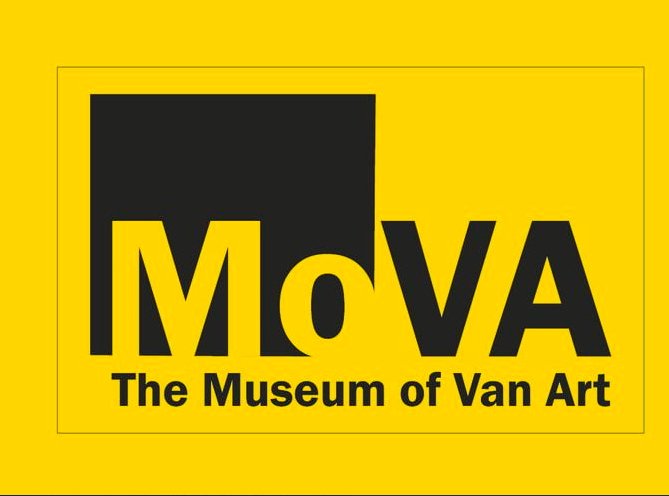
Ara, a programmer for nearly 3 decades, says
“An algorithm is not mysterious – it’s not an autonomous being running riot – it is just a set of instructions, commands – like a simple recipe. The person giving the instructions should bear some responsibility for what they are being programmed to do”
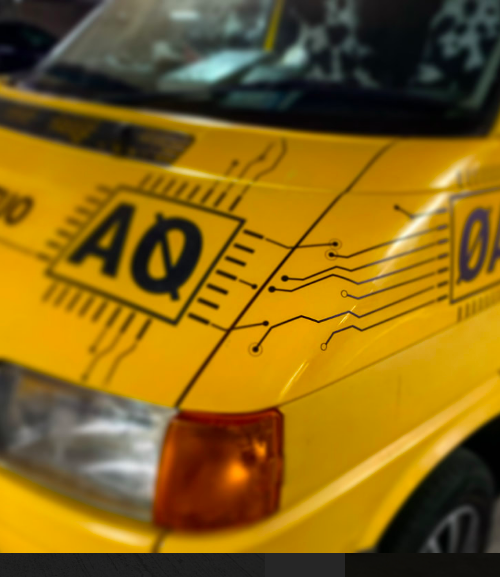
The concept for MoVA was born out of Ara’s frustration with the government’s disregard for the rules they were setting for everyone else to follow during the Covid-19 pandemic culminating in the Cummings incident. Exasperated, Ara took a whiteboard marker to her van writing ‘Keep Back: Eye Test in Progress’. Sightings of the van went viral on multiple online platforms and drew people into conversations on the street – realising the van provided an excellent platform for engagement, MoVA (a pun on MoMA) was born and the graffiti became the inaugural exhibition “Testing Times”. While the first iteration was a quick reaction that hit the spot the second is more thoughtful and deals with more complex and polarising issues.
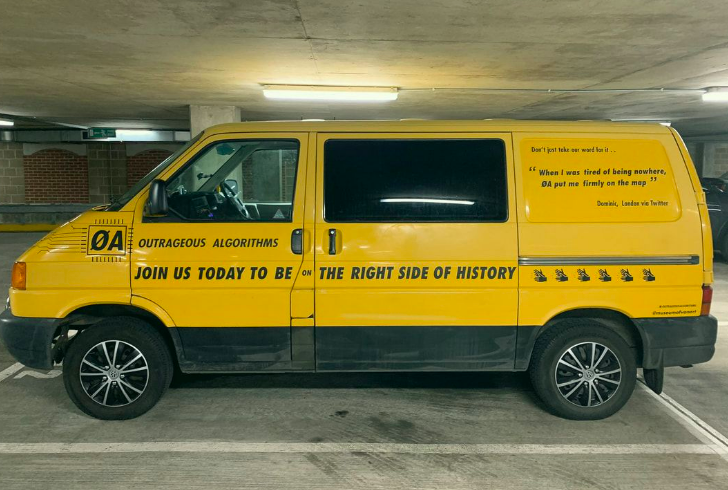
Outrageous Algorithms – a solo presentation by Rachel Ara MoVA until – 14.11.2020
UK & European Tour: London, Essex, Scotland, France, Spain, Lisbon, Jersey
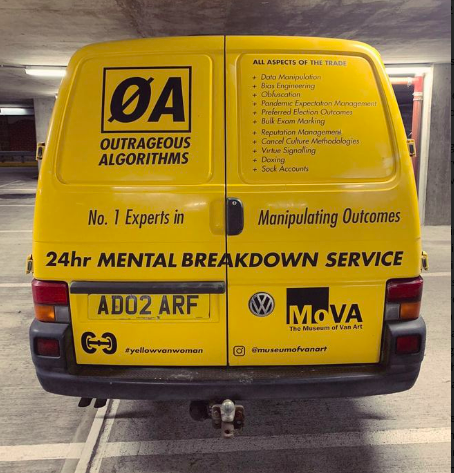
About Rachel Ara … (b. 1965 Jersey, CI) studied BA Fine Art at Goldsmiths (1994–97); . Selected groups exhibitions include: Vertiginous Data, MMCA (Museum of Modern and Contemporary Art), Seoul, S.Korea (2019); London Design Festival, V&A, London (2019); Vienna Biennale, The MAK, Vienna (2019); London Open 2018 Triannual, Whitechapel Gallery, London, UK (2018) . Solo presentations: “Dissent Module (Escape from Semiramis)”, UCL / Slade, London, UK (2020); “Transubstantiation of Knowledge”, V&A, London, UK (2018); *“American Beauty (A Trump L’Oeil)”, Barbican Centre, London, UK (2018); . Recent prizes include: International Aesthetica Art Prize, First Prize (2016), the coLAB “Women Make Sculpture commission” and Awards from the Arts Council (2019 / 2020). Recent Publications: 100 Sculptors of Tomorrow, Thames & Hudson (2019), 50 Women Sculptors, Aurora, (2020), She lives and works in London.
Ara is best known for her seminal piece “This Much I’m Worth” a 7m long neon digital sculpture that calculates its own value in real time. The work has been shown internationally in major museums and made the cover and a feature story in the Financial Times Wealth Magazine.
About MoVA …The Museum of Van Art (MoVA) is an ex-AA VW TD4 with nearly 200k miles on the clock. Ara regularly drives around the UK and Internationally to show
“It’s totally liberating showing work like this, outside the mainstream, which is really where the artist should be. It’s direct, relevant and of the moment and makes use of the resources at hand. There are no gatekeepers or censorious curators filtering the work and you get to communicate directly with people who might never go to a gallery. It is invigorating to get feedback and criticism from the public – which is ultimately what you want – to provoke discourse and agitate debate.”
